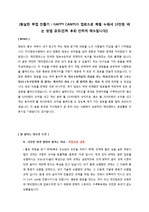동아시아 무형문화유산 보호제도와 유네스코 협약
* 본 문서는 배포용으로 복사 및 편집이 불가합니다.
서지정보
ㆍ발행기관 : 한국미술연구소
ㆍ수록지정보 : 美術史論壇 / 34권
ㆍ저자명 : 박계리
ㆍ저자명 : 박계리
영어 초록
Korea’s intangible cultural heritage protection system was first established in 1962 based on Japan’s model, and began to accumulate its full-scale experiences of operations in the 1970s. Over time, it shifted to a more Korean model, imbued with the strong nationalism of the people and spurred by a passionate commitment to preserving traditional culture endangered by industrialization. Korea’s system features the principles of priority protection and preservation of original forms, and includes a government-led apprentice training system and regulations for the mandatory presentation of skills or performances.In contrast, UNESCO’s “Convention for the Safeguarding of the Intangible Cultural Heritage (2003)” takes a different approach, emphasizing the participation of communities, groups and individuals based on cosmopolitanism and tradition, as well as the devising of comprehensive policy directions that embrace not only preservation of intangible cultural heritages but also development and enhancement. UNESCO’s position is opposite to Korea’s intangible cultural heritage safeguard system which, as mentioned, is based on nationalism and the preservation of original forms, and features a governmentled training system and regulations on the mandatory presentation of skills or performances.
China, in its “Notice on Strengthening Protection of Cultural Heritages by the State Department (國務院關于加强文化遺産保護的通知) (2005)” and “The People’s Republic of China’s Intangible Cultural Heritage Protection Act (2011),” embraces UNESCO’s concept of intangible cultural heritages and its comprehensive safeguarding methodology while at the same time accepting the Korean approach of priority protection based on a government-led training system and mandatory regulations. China applied Korea’s methodology after conducting in-depth studies and reviews on the Korean and Japanese intangible cultural heritage protection models, in particular the Korean “Cultural Heritage Protection Act (amended in 2008).” In its protection efforts, China also carries out systematic and full-scale research, recording and indexing projects in consideration of its vast territory and diverse traditional cultures. By combining all of these approaches, China has emerged as a powerhouse of intangible cultural heritages in East Asia.
Changing trends related to the intangible cultural heritages of East Asia require shifts in relevant policies, making it urgent for Korea to seek measures that compliment rather than abolish its 40 years of experience in safeguarding intangible cultural heritages and allow for the incorporation of international standards presented by the UNESCO Convention.
To elaborate on such measures, it is believed that Korea could again lead the intangible heritage safeguarding environment in East Asia if it establishes a new and advanced intangible cultural heritage protection system. Such a system should be based on expanding the concept of intangible cultural heritages in terms of scale and objects; enhancing understanding on the organic interrelationship between intangible and tangible cultural heritages; developing insight into the real intention of Korean and UNESCO theories on the process of tradition; reviewing the merits of government-led priority protection experiences and the comprehensive protection initiatives carried out by individuals and communities; embracing Korea’s training system and China’s investigation system; and reflecting the love of national cultural heritage within Korea’s “Cultural Heritage Charter (1997)” and the multicultural embrace underlying UNESCO’s “Convention for the Safeguarding of the Intangible Cultural Heritage (2003).”
참고 자료
없음태그
"美術史論壇"의 다른 논문
 ‘優塡王式 불입상’의 형성·복제 그리고 확산28페이지
‘優塡王式 불입상’의 형성·복제 그리고 확산28페이지 셋슈의 중국회화 인식에 대하여20페이지
셋슈의 중국회화 인식에 대하여20페이지 高麗佛畵의 변죽: 本地, 畵幅, 奉安에 대한 問題31페이지
高麗佛畵의 변죽: 本地, 畵幅, 奉安에 대한 問題31페이지 한국 <郭汾陽行樂圖> 연구38페이지
한국 <郭汾陽行樂圖> 연구38페이지 김홍도 생애의 재구성35페이지
김홍도 생애의 재구성35페이지 초상에 담지 못한 사대부의 삶: 이명기와 김홍도의 <徐直修肖像>26페이지
초상에 담지 못한 사대부의 삶: 이명기와 김홍도의 <徐直修肖像>26페이지 고대 동남아시아의 귀걸이 전통과 그 영향28페이지
고대 동남아시아의 귀걸이 전통과 그 영향28페이지 재조선 일본인 화가 구보타 덴난(久保田天南)과 朝鮮南畵院28페이지
재조선 일본인 화가 구보타 덴난(久保田天南)과 朝鮮南畵院28페이지 김환기의 <종달새 노래할 때>(1935)에서 <항아리와 여인들>(1951)까지24페이지
김환기의 <종달새 노래할 때>(1935)에서 <항아리와 여인들>(1951)까지24페이지 한국 현대미술에 나타난 모성도상의 의미28페이지
한국 현대미술에 나타난 모성도상의 의미28페이지



























